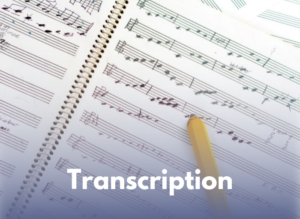Unleash The Musicality You Have Inside.
Online training that makes you more musical.Musical U exists to fill a gap in music education: to teach the inner skills which let you feel like a “natural” in music, including playing by ear, improvising, composing, musical confidence and expressiveness.
Through our podcast “Musicality Now”, thousands of free articles and tutorials, a flagship membership program and dedicated online courses, we help passionate adult musicians to tap into their “inner natural” and develop their true musicality.

– Musical U Director, Christopher Sutton

As seen in







Listen Or Watch:
Musicality Now
Discover the most powerful tools, strategies and insights with Musical U director Christopher Sutton and more than 100 of the world’s leading experts on developing your musicality.
Featuring world-leading experts:

Jermaine Griggs
Hear And Play

Glory St. Germain
Ultimate Music Theory

Marshall McDonald
The Count Basie Orchestra

Dame Evelyn Glennie
The World's Premiere Solo Percussionist

Professor Anders Ericsson
Leading Scientific Researcher on "Talent"

Noa Kageyama
The Bulletproof Musician

Gerald Klickstein
The Musician's Way

Steve Myers
Theta Music Trainer

Paul Wertico
Grammy-Award-winning drummer
“Perfect for what I wanted to do gain a full understanding of music in order to become a better all-round musician”
“Since becoming a member I’ve really gotten into rhythm, had success with melodic intervals and chord progressions and I can now quite easily pick out a tune by ear.”
“I can now recognize some chord progression in popular music and I listen more closely to songs on the radio. This helps me be more musical as I can use it when writing new songs.”
“I feel a eureka moment of understanding. I now understand the value of ear training and am equipped with the knowledge and tools to fully appreciate and analyse music.”
Meet the Team
Christopher Sutton
Founder and Director
“I grew up as “the musical one” in my class, learning to play several instruments and performing regularly with bands and orchestras.
But I never felt like a “real” musician.
I couldn’t freely play the music I heard or create my own music confidently. I’d listen to albums I loved and have no idea how that music was put together. It really frustrated me that the music I played seemed totally separate from the music I loved listening to.
Even though I was good at playing guitar and piano, I felt really limited because I had to go out and find sheet music before I could play songs – even the songs I listened to all the time and felt like I should know inside-out!
Then I discovered ear training and found that all those skills I’d desperately wanted – like playing notes and chords by ear, improvising and jamming along – were things you could learn.
The ear training process was old-fashioned and boring – but it was powerful.
That’s why I founded my company in 2009 – to bring ear training into the 21st century by using technology to make it fun and easy.
My mission is to help musicians who are struggling (like I was) to break free of their false limitations and bring out their true inner musicality.”
→ Learn more about Christopher

Adam Liette
Operations Manager
Adam Liette is a lifelong musician in many styles of music. He is a veteran of the United States Army Band and has performed all around the world, including for Presidents Barack Obama and George W. Bush. A classically trained trumpet player and heavy metal guitarist, these days Adam enjoys teaching his children to love and appreciate music.

Zac Bailey
Community Assistant
Zac has been DJ’ing, producing and rapping for almost 20 years. He’s had original songs and remixes released across multiple labels from all over the world under his moniker, ZSonic.
Dedicated to spreading the awareness of the turntable as an instrument, he has recently started a website focused on showcasing and teaching the musicality and art of the turntablist.
At Musical U Zac is a Community Assistant inside the membership site, helping others achieve their goals and discover how music can enrich their lives.

Stewart Hilton
Community Conductor
Stewart has had a passion for music for many years and his enjoyment of guitar has given him to opportunities to play in a wide variety of styles. His appreciation of music has also been developed through teaching guitar, running sound, doing sales for music manufacturers, and mixing and producing his band’s latest CD. However, some of Stewart’s greatest satisfaction is being able to empower others to help them achieve their own personal success.

Sabrina Peña Young
Contributing Educator
Award-winning composer Sabrina Peña Young is best known for her groundbreaking animated opera Libertaria. Her expertise spans over a decade and a half of commercial and classical music from jazz to folk to film soundtracks and dance electronica. She is a key contributor in the Musical U team, composing the music of the Unravelling Music training modules and creating resources to help members develop their natural sense of rhythm.

Andrew Bishko
Product Manager
Andrew Bishko is a veteran of music performance and teaching, with a career spanning decades and a wide variety of genres. His current projects include HeartWinds (an acoustic jazz/world music duo), Mariachi Flor de Missouri, The Ozarks Klezmer Orkestr, and music minister / songwriter / composer in an all-original church music program.

Anastasia Voitinskaia
Content Assistant
After years of forced classical conservatory piano training, something clicked with our Assistant Editor Anastasia Voitinskaia. She has since moved on to guitar, bass, Ableton Live, and Montreal’s bubbling music scene.
Together with Andrew and the team, Anastasia is responsible for the steady stream of informative content getting published on the Musical U website.
instrument specialists
Resident Pros

Ruth Power
Resident Pro for Piano
Ruth Power is a dynamic piano tutor and founder of PianoPicnic.com: a piano learning hub featuring short burst lessons inspired by the concept of micro-training.
Now based in New Zealand, Ruth has developed music education resources for the past 11 years and has worked with clients such as Rhinegold Education, Rockschool UK, Novello & Co, MusicRoom, Rock Star Recipes & the Royal Academy of Dance.
Her signature piano course ‘Songs By Ear’ teaches the fundamentals of playing by ear directly to the student in a way that is quick, easy, fun and all from your e-device or tablet.

Steve Lawson
Resident Pro for Bass
Steve Lawson is renowned above all else for his creativity and pushing the boundaries of what’s possible on the bass.
He has published over a dozen solo albums, regularly performs live, is a respected thought-leader on the future of music education, and is currently doing a PhD on the topic of improvisation.
Steve is known worldwide for his pioneering work in solo bass, employing techniques and technology to create fascinatingly rich recordings and live performances that sound nothing like you might expect from a bass guitar.

Clare Wheeler
Resident Pro for Singing
Clare Wheeler is a former member of The Swingles (a.k.a. “The Swingle Singers”), arguably the most revered and respected a cappella group in the world.
As well as her extensive performing background in The Swingles, Clare also has a passion for teaching.
She has run workshops, directed choirs, and taught one-on-one, and she specialises in the two major areas we focus on for singers at Musical U: helping beginner-stage singers master pitching and gain confidence, and helping singers of all levels develop their musicality and ability to improvise and be creative in music.

Dylan Welsh
Resident Pro for Guitar
Dylan Welsh is an impressive figure in the Seattle music scene. He regularly performs live and records in studio, so he understands both the practicalities of being a working musician and the importance of investing in the bigger-picture skills of musicality.
Through providing online guitar lessons he is continually honing his own skills as a teacher and finding new ways to help students learn faster using the music they personally enjoy most.





























